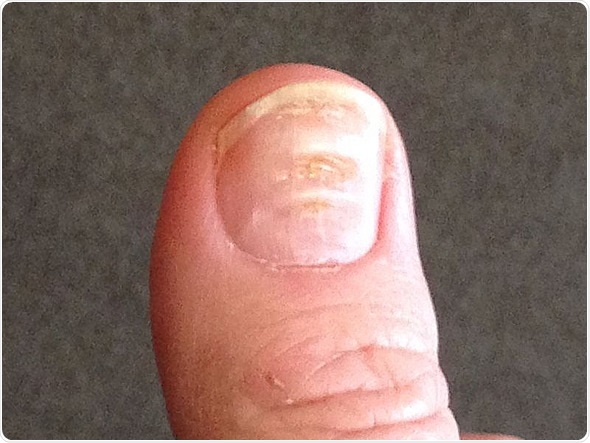Fingernails are mirrors of health and disease. They show several kinds of change, such as splinter hemorrhages or clubbing, which relate to specific illnesses. However, Beau’s lines are non-specific deep transverse linear depressions or trenches across the nails which occur in situations such as:
- Illnesses such as serious forms of fever, stress or myocardial infarction
- Nail injury
- Eczema of the periungual skin
- Malnutrition
- Cancer chemotherapy
- Exposure to cold temperatures in the presence of Raynaud’s disease
- Trauma
- Pemphigus
- Severe infection
- Hypotension or shock
- Hypocalcemic states

These lines were first described in 1846. They are characteristically seen at the same part of the nail plate, in most or all of the nails. It is possible to identify which disease process caused these lines by measuring how far away they are from the nail bed, because nails grow at a rate of approximately 1 mm every 6-10 days. They are the most common nail change in systemic disease, as well as the least specific.
In rare cases, Beau’s lines are inherited or idiopathic.
Types of Presentation
Single transverse grooves represent an episode of severe stress or illness, while a series of lines show recurrent episodes. If the nail stops growing for at least 7 weeks, the line becomes very deep, and this is called onychomadesis. The width of the line shows the duration of the disease. A sudden attack of disease results in a Beau’s line with a steep distal end, but a more insidious onset is suggested by a sloping distal margin.
When Beau’s lines are seen on all the fingernails, the person may have a history of illnesses such as:
- Mumps
- Pulmonary infections
- Thrombosis of the coronaries
- Kawasaki disease
- Syphilis
- hypoparathyroidism
Pathogenesis of Beau’s Lines
The nail is correctly called the nail plate, and is made up of keratin. It covers the dorsal part of the end of the last phalangeal bone, and protects the skin from trauma. It is essentially composed of tightly-packed dead skin cells, and is produced by the nail matrix, which is the living and growing layer of the nail, at the part of the nail bed that is closest to the finger.
Growth of the nail produces more and more keratin. The distal part of the matrix gives rise to the deeper nail layers. Problems with the distal matrix will thus cause ridging or splitting of the nails due to the disturbance of the deeper layers. On the other hand, the proximal nail matrix generates the superficial nail layers. It is affected by conditions such as psoriasis, which produces characteristic pitting of the nail.
Transient problems with nail growth will produce temporary disturbances with nail growth. This includes the transverse band-shaped indentations that are called Beau’s lines. Thus any systemic illness that is severe enough to interfere with normal cell division will lead to a cessation of the normal growth of the nails for a period. This is sufficient to produce these lesions. The grooves themselves only become noticeable after several weeks when the nails have grown enough for the depressed areas to be seen clearly.
Treatment of Beau’s lines depends upon identifying the underlying condition and correcting it. The lines themselves grow out and eventually disappear.
References
- http://www.aafp.org/afp/2004/0315/p1417.html
- http://www.nhs.uk/conditions/nail-abnormalities/Pages/Introduction.aspx#Beaus
- http://www.ncbi.nlm.nih.gov/pmc/articles/PMC4375768/
- http://www.nejm.org/doi/pdf/10.1056/NEJMicm040187
- http://stanfordmedicine25.stanford.edu/the25/hand.html
- http://www.japi.org/april_2011/PC_Beaus_Lines.pdf
Further Reading
- All Nails Content
- Nail Discoloration – Green, Blue, Black, White or Yellow, Why ?
- Types of Nail Disease
- Bacterial Nail Infections
- Median Nail Dystrophy
Last Updated: Mar 21, 2019

Written by
Dr. Liji Thomas
Dr. Liji Thomas is an OB-GYN, who graduated from the Government Medical College, University of Calicut, Kerala, in 2001. Liji practiced as a full-time consultant in obstetrics/gynecology in a private hospital for a few years following her graduation. She has counseled hundreds of patients facing issues from pregnancy-related problems and infertility, and has been in charge of over 2,000 deliveries, striving always to achieve a normal delivery rather than operative.
Source: Read Full Article
